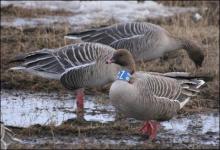Current Size: 76%
Arctic tundra degradation: late snow melt and grubbing
Summary
Monitoring and assessing the impact of pink-footed geese on arctic tundra vegetation is a fundamental part of the ISMP. A study has been published describing and assessing the extent of arctic tundra degradation on Svalbard, Norway caused by grubbing, where pink-footed geese forage for rhizomes below-ground. The study assessed grubbing extent (occurrence of vegetation disturbance) and intensity (proportion of vegetation disturbed) in 2006/07/08 when goose numbers were approximately 56,000 and in 2013 when they increased to approximately 81,000. Despite a 36% increase in population size, in 2013 the grubbing extent at pre-breeding sites was similar to that in 2007/08 but grubbing intensity was lower. The study suggests that extensive snow cover in 2013 probably dispersed geese over larger areas in search of snow-free patches for feeding, thereby reducing grubbing intensity. Whilst, at the largest known breeding site, both grubbing extent and intensity increased with more geese. Birds preferentially fed close to nests in previously grubbed wet habitat, probably aiding nest defence and permitting feeding on plants that were easier to remove from the soil. The study concluded that a greater impact on tundra vegetation may occur at nesting areas if the breeding population continues to grow. However, timing of snowmelt appears key in moderating the impact of disturbance on tundra vegetation since it controls spatial distributions of feeding geese.
The study is described in a paper published in Écoscience and is available on-line.
Citation: Anderson, H. B., J. D. M. Speed, J. Madsen, Å. Ø. Pedersen, I. M. Tombre and R. van der Wal (2016). "Late snow melt moderates herbivore disturbance of the Arctic tundra." Écoscience 23(1-2): 29-39.















